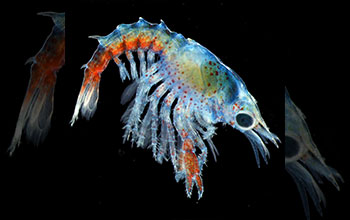Multimedia Gallery
'American lobster larva,' by Jesica Waller, Halley McVeigh and Noah Oppenheim
"American lobster larva," by Jesica Waller, Halley McVeigh and Noah Oppenheim.
As a master's student in marine biology at the University of Maine, Jesica Waller spent the summer taking pictures of baby lobsters. Increasingly warm and acidic oceans affect many marine species, and so Waller raised thousands of lobsters in the lab -- no easy task, since young lobsters tend to eat one another -- to see how different climate-change scenarios alter their development.
This image of a live three-week-old specimen was one of thousands Waller took. It captures the distinct, delicate hairs on the legs. Since lobsters have very poor vision, they rely on their leg hairs for sensory tasks such as finding food. Adults have them too, meaning baby and grown-up lobsters alike taste with their feet.
More about this image
This illustration won people's choice in the Photography category of the 2016 Visualization Challenge, now called the Vizzies, a long-running annual competition co-sponsored by the U.S. National Science Foundation and Popular Science magazine. [The competition was formerly named the International Science & Engineering Visualization Challenge (SciVis) and was previously co-sponsored with AAAS' journal Science.] The competition aims to recognize some of the most beautiful visualizations from the worlds of science and engineering, and awards prizes in five categories: photography, video, illustration, posters & graphics and interactives.
To learn more about the competition and view all the winning entries, past and present, see the NSF Special Report The VIZZIES: Visualization Challenge. (Date image taken: 2016; date originally posted to NSF Multimedia Gallery: Jan. 2, 2018)
Credit: Jesica Waller, Halley McVeigh and Noah Oppenheim
Images and other media in the National Science Foundation Multimedia Gallery are available for use in print and electronic material by NSF employees, members of the media, university staff, teachers and the general public. All media in the gallery are intended for personal, educational and nonprofit/non-commercial use only.
Images credited to the National Science Foundation, a federal agency, are in the public domain. The images were created by employees of the United States Government as part of their official duties or prepared by contractors as "works for hire" for NSF. You may freely use NSF-credited images and, at your discretion, credit NSF with a "Courtesy: National Science Foundation" notation.
Additional information about general usage can be found in Conditions.
Also Available:
Download the high-resolution JPG version of the image. (3.6 MB)
Use your mouse to right-click (Mac users may need to Ctrl-click) the link above and choose the option that will save the file or target to your computer.



